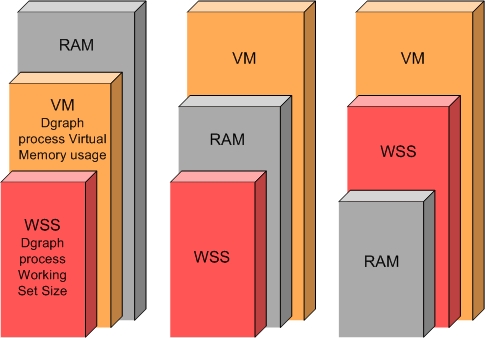While the amount of virtual memory consumed by the Dgraph process may grow and even exceed RAM at times, it is important for performance reasons that the working set size of the Dgraph process does not exceed RAM.
The following diagram illustrates this relationship:

In this diagram:
- RAM is the amount of physical memory
- VM is the Dgraph process virtual memory usage
- WSS is the Dgraph process working set size
The diagram illustrates three distinct use cases:
- Typical operation with normal memory saturation. The graph on the left side illustrates the case where the amount of virtual memory used by the Dgraph process completely fits into RAM and thus the working set size of the Dgraph process also fits into RAM. This is a standard situation under which the Dgraph maintains its optimal performance.
- Typical operation in an out-of-memory situation. The graph in the middle illustrates the case where, while the amount of virtual memory exceeds RAM, the working set size of the Dgraph process fits into RAM. In this case, the Dgraph also maintains its optimal performance.
- Potentially I/O bound operation with poor performance where WSS starts to exceed RAM. The graph on the right side illustrates a situation that you should avoid. In this case, both the amount of virtual memory consumed by the Dgraph and the working set size of the Dgraph exceed RAM. Two situations are possible in this scenario that are of particular interest to you: the WSS can start to exceed RAM mildly or significantly. Subsequently, the degradation in I/O performance can also be mild or significant. Identify the level of I/O performance that is acceptable to your implementation. Depending on the acceptable I/O performance, you can decide whether you need to address the situation with WSS exceeding RAM. In general, if WSS starts to considerably exceed RAM, this causes Dgraph performance to drop dramatically.
